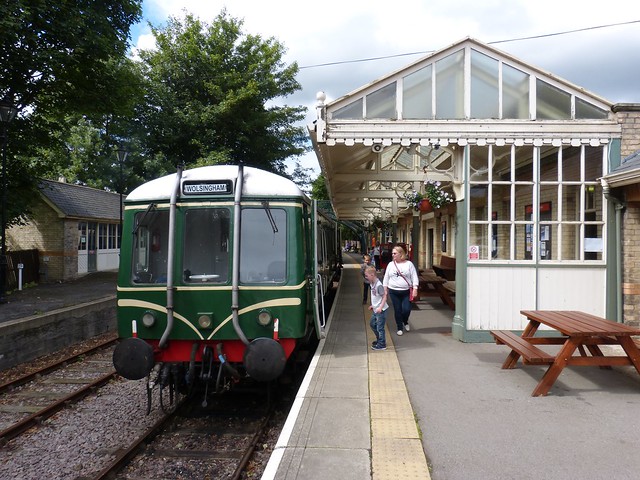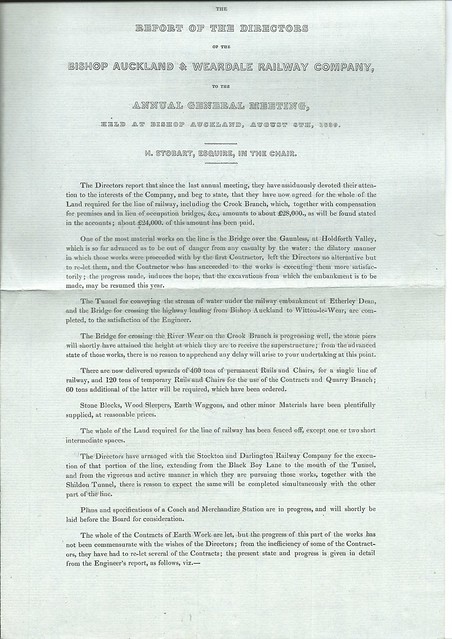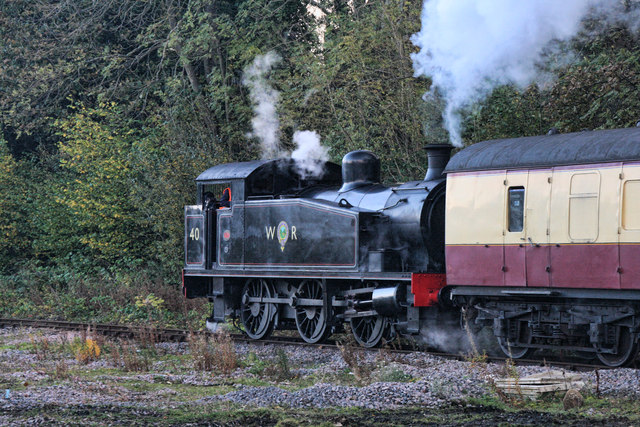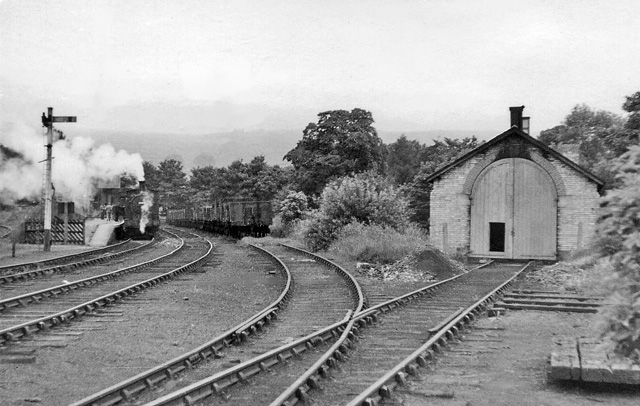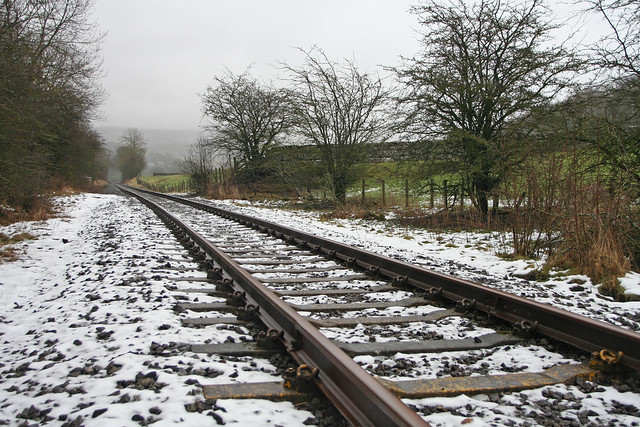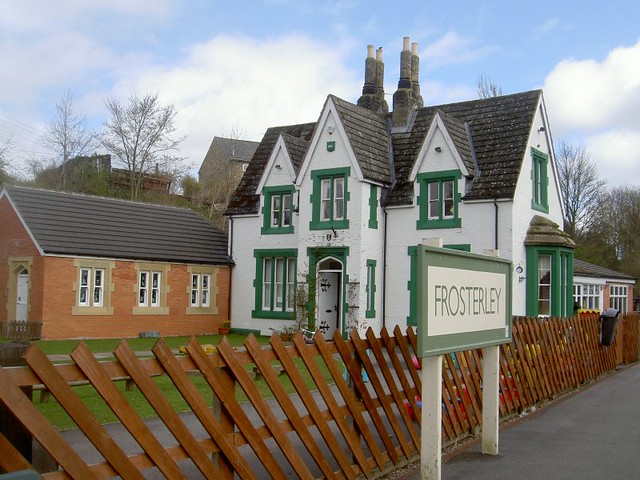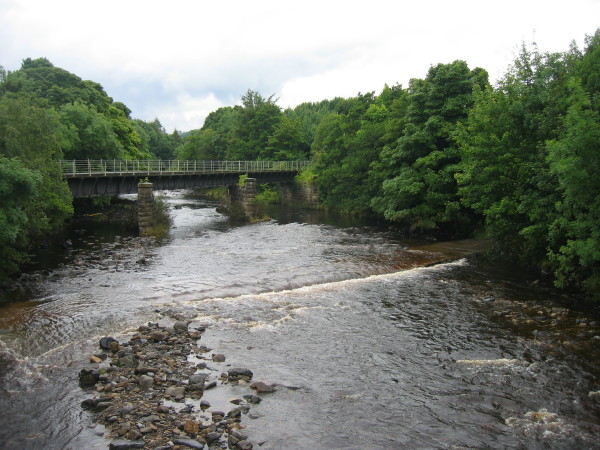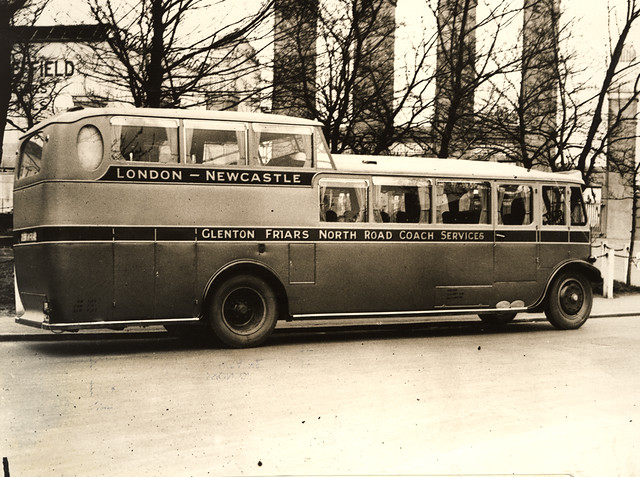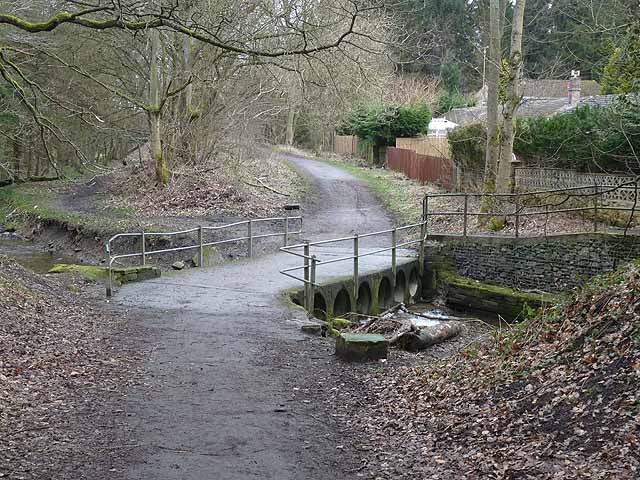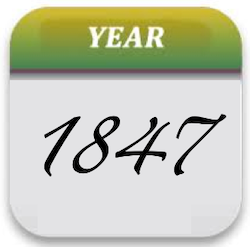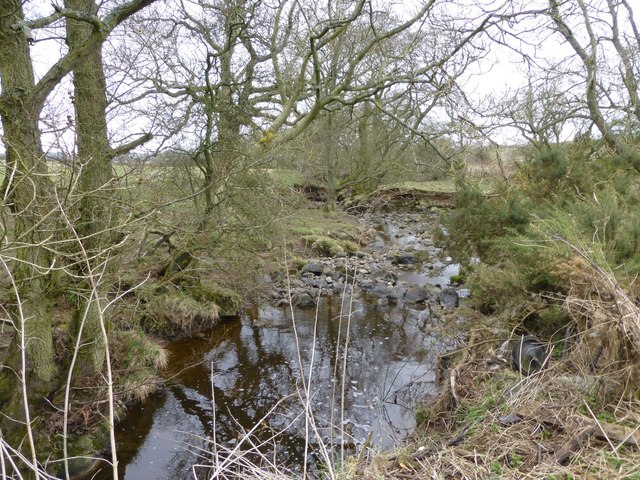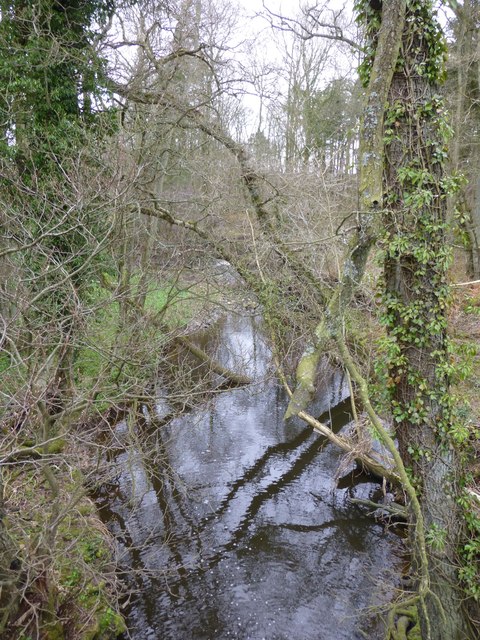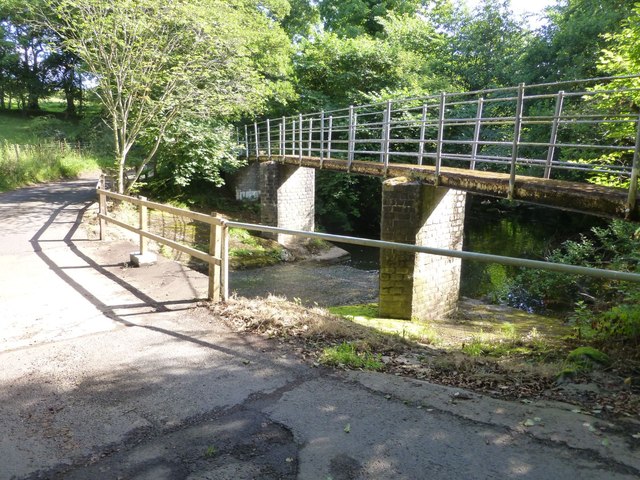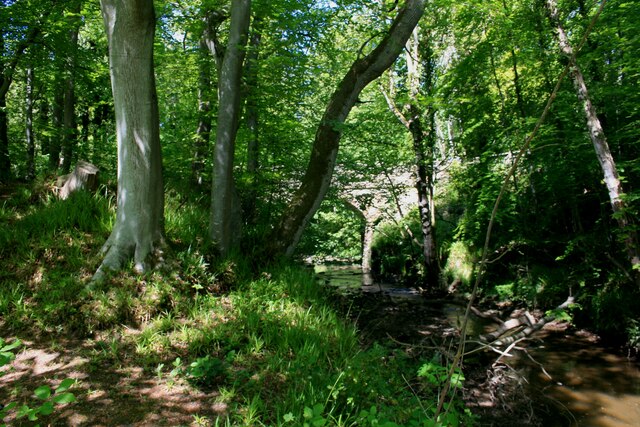Topics > Transport and Travel > Railway > Weardale Railway
Weardale Railway
"The Weardale Railway, situated in County Durham, U.K. was a mothballed branch line from Bishop Auckland following the River Wear westwards to Eastgate-in-Weardale, a distance of approximately 18.7 miles (30km). (Find us). The line was originally built by the Stockton & Darlington Railway in 1847 to transport limestone to the ironwork of Teesside, and by 1895 had been extended to its final terminus of Wearhead. Although the passenger service was withdrawn in 1953 (apart from a limited summer Sunday service between 1988 and 1992), the line was retained for freight use transporting bulk cement from the Blue Circle works at Eastgate. This use also ceased in 1993, so the line was mothballed and threatened with lifting. With support from Wear Valley District Council, 1993 saw the formation of The Weardale Railway Preservation Society...." (Weardale Railway Trust)
The Weardale Railway is an independently owned British single-track branch line Heritage Railway between , Witton-le-Wear, Wolsingham, Frosterley and Stanhope. Weardale Railway services began on 23 May 2010, but decided to run special trains rather than a scheduled service for the 2013 season.
The railway originally ran from Bishop Auckland to Wearhead in County Durham, North-East England, a distance of , built in the nineteenth century to carry limestone from Eastgate-in-Weardale, and provide passenger services to Weardale. Passenger services were ceased in 1953, leaving only freight services to Eastgate until 1992.
After the quarries owner Lafarge moved to road transport in 1993, under the threat of closure by British Rail, the line was taken over by a group of enthusiasts. The Weardale Railway currently runs for between Bishop Auckland and the site of Eastgate-in-Weardale Station, making the line one of the longest preserved standard gauge heritage railways in Great Britain.
Background
Bishop Auckland gained its first rail link in 1842, when the Stockton and Darlington Railway (S&DR) backed Bishop Auckland and Weardale Railway (BA&WR) gained the powers via an Act of Parliament to build a railway line from the S&DR's station at via Bishop Auckland and Witton-le-Wear into Crook, County Durham. The BA&WR initially built a temporary terminus at South Church, which opened on 19 April 1842. After completion of the Shildon tunnel, the BA&WR erected a permanent station on the current site, which opened to freight on 8 November 1843, and passengers on 30 January 1843. All operations were sub-leased as agreed to the S&DR.
In 1844, after the West Durham Railway extended from a junction with the Clarence Railway at to Crook, the S&DR extended the BA&WR from Bishop Auckland along the river valley to Witton-le-Wear, and then into Crook. In 1845, the S&DR came to an agreement with the Derwent Iron Company to sub-lease the southern section of the former Stanhope and Tyne Railway. It extended the line from Crook to and then to Blackhill. That line was opened as the Weardale Extension Railway (WXR).
In July 1845 Parliament passed the Wear Valley Act, which allowed the extension of the BA&WR from a junction at Witton-le-Wear to , and a small branchline across the river to Bishopley. With all works again undertaken by the S&DR, this line opened on 3 August 1847. After these works had been completed, the BA&WR amalgamated with the WXR. All service were operated by the S&DR, which officially took over the new company in January 1857.
In 1862, an Act of Parliament was passed allowing the S&DR backed Frosterley & Stanhope Railway to extend the line to , thus allowing trains to transport limestone from the Newlandside Estate on the south side of the town.
The final extension of the Weardale Railway to opened on 21 October 1895. Between Eastgate and Westgate at Cambo Keels, sidings were established to serve the Weardale Iron Company's Heights limestone quarry, which is still in operation today.
Decline and closure
As elsewhere the UK, rail traffic in the area declined after World War II, with the Wearhead branch the first to lose its passenger trains in 1953. The principal closures came in the 1960s post the Beeching Axe, with services to: Barnard Castle via West Auckland ending in 1962; Durham in 1964; and Crook in 1965. This left only the former original S&DR line to line in operation, along with the freight-only branch traffic to Eastgate.
Durham County Council recognised the value of the line to leisure services by 1983, when with the patronage of David Bellamy intermittent specials began to serve Stanhope again under the banner of "The Heritage Line", because of the S&DR association. This became a scheduled service weekend only summer service, printed in the BR public timetables, between 23 May 1988 and 27 September 1992. Etherley, otherwise known as Witton Park Station, was re-opened on 21 August 1991. It has not re-opened under the post 2010 Weardale Railway operation.
In March 1993, Lafarge decided to service the Eastgate cement works by road and end its use of rail. British Rail then announced its intention to close the line due to the loss of revenue. Local authorities sought another use for the line and considered that the only immediate possibility was a steam-hauled tourist service.
Formation of Weardale Railway Trust
Class 141 at Weardale Railway.jpg|right|thumb|A class 141 railbus forms the majority of passenger services on the Weardale Railway; here 141103 is pictured at Stanhope station in early 2008
The Weardale Railway preservation project was founded in 1993, with the intention that a private company should take ownership of the line and start a steam service for tourists on the scenic western section. The operating company was known as the Weardale Railways Ltd, a company limited by guarantee.
The Weardale Railway Trust (WRT) is a voluntary group whose members are supporters of the project. WRT was initially just a "supporters' club" but it assumed a more prominent role as Weardale Railways Ltd got into difficulties. In 2006 WRT took a 12.5% minority stake in the ownership of Weardale Railways Ltd.
Large sums of public sector grant finance were obtained or conditionally pledged from various donors including the Regional development agency (One NorthEast), Durham County Council and the Wear Valley District Council. The Manpower Services Commission contributed to the wages of paid staff in what had become an area of high unemployment, and this allowed a 40-strong workforce to be recruited, a depot and base of operations to be established at Wolsingham and the station at Stanhope to be restored. Services started in July 2004, initially from Wolsingham to Stanhope but with the intention of extending them along the full length of the remaining line. There were even plans to rebuild the Eastgate to Wearhead section which had been lifted.
Eventually, a community interest company known as Ealing Community Transport agreed to pay £100,000 for a 75% stake in Weardale Railways Ltd and provide management support to the project. Ealing Community Transport also agreed to underwrite any further operating losses incurred by Weardale Railways Ltd. This undertaking was sufficient to allow the creditors of Weardale Railways Ltd to permit the resumption of limited services on the line in August 2006.
British American Railway Services
In September 2008, Ealing Community Transport's 75% interest in WRC was transferred to British American Railway Services, a wholly owned subsidiary of US private company Iowa Pacific Holdings. Ed Ellis, the spokesman for these firms, visited the Weardale Railway in October 2008, and announced an intention to reopen the line to Bishop Auckland by the end of 2008.
In October 2008, the line's paid staff and volunteers undertook the "Brush Blitz" to clear 14 years of vegetation growth from the track between Wolsingham and Bishop Auckland. After two damaged sections of track were repaired, in early 2009 a passenger-carrying Wickham trolley (light rail vehicle) was able to negotiate the line from Wolsingham to within sight of Bishop Auckland station. Ellis also announced plans to build a rail freight terminal at Eastgate for the loading of aggregates from local quarries together with other freight, including mineral, food and agricultural commodities.
On 27 March 2009 the railway's website reported that Network Rail had undertaken to re-install missing points and crossings at Bishop Auckland to reconnect the Weardale Line with the national rail network. It was stated that this would be done before 31 July 2009. Network Rail completed the connection in early September 2009. On 29 September 2009, the development of the Eastgate Renewable Energy Village received unanimous outline approval by the County Durham strategic planning committee, thus providing a potential boost to the line's future prospects. By 2013 this project appeared stalled.
In December 2009, it was announced that UK Coal was interested in using the line to transport coal from an opencast (open pit) coal mine in the line's catchment area and that local quarry owners had been approached about the possibility of shipping aggregates along the line. This is intended to ensure the future of the line as a viable business.
Operations
On 25 January 2010, Her Majesty's Railway Inspectorate travelled on the Weardale line checking bridges, fences and crossings along the 18-mile stretch between Stanhope and Bishop Auckland. Only a few minor works were needed to get the line ready for passenger use, and these were completed in time for a to Stanhope charter train to run. In February 2010, this became the first mainline passenger service to travel the line since the 1980s. It was followed on 27 February by a railtour from Crewe to Stanhope, operated by Spitfire Railtours.
Regular passenger services to Bishop Auckland started on 23 May 2010, but for the 2013 season a scheduled service was not offered, the railway instead offering themed operations, such as Dine and Ride and the Polar Express.
During 2014, the Railway Trust operated passenger trains on selected weekdays and weekends for mostly tourist traffic. This was just running between Wolsingham and Stanhope Stations.
After received planning permission to load opencast coal, mined in the Crook area. The first loaded coal train left Wolsingham on 16 June 2011 bound for steel works in Scunthorpe. It was hoped that this would become a five-train-a-week operation. These operated until 2 October 2013.
Stations of the Weardale Railway
- Westgate-In-Weardale Station (Planned)
- Eastgate-In-Weardale Station (Planned)
- Stanhope Station 54.743°N 2.003°W (Current Terminus)
- Frosterley Station 54.727°N 1.964°W
- Wolsingham Station 54.726°N 1.884°W
- Harperley Station (Currently Disused)
- Witton-le-Wear (Re-open, Easter 2016)
- Wear Valley Junction (Currently Disused)
- Etherley (Currently Disused, the railway plans to re-open it as Witton Park)[9]
- Bishop Auckland West Station
Rolling Stock
This list is incomplete; you can help by expanding it.
Steam Locomotives
- N.C.B. 40, Robert Stephenson & Hawthorn 0-6-0T (7765 of 1954).[26] Under overhaul.
Diesel Locomotives
- BR Class 31 no. 31144 (spares)
- BR Class 31 no. 31452 (under repairs)
- BR Class 31 no. 31454 (Left for overhaul at Washwood Heath, December 2013)
- BR Class 31 no. 31468 (stored)
- BR Class 31 no. 31602 (stored)
Diesel Multiple Units
- BR Class 122 no. E55012 (operational)
- BR Class 141 units 141103 (operational) and 141110 (not operational).
Visit the page: Weardale Railway for references and further details. You can contribute to this article on Wikipedia.

from Flickr (flickr)
Stockton and Darlington, Weardale and Redcar Railways timetable 1847
Pinned by Simon Cotterill

from http://www.weardale-railway.o…
Weardale Railway Trust
- "The Weardale Railway Trust is a partner in the Weardale Railway Project. We are the supporting volunteer charity for the project and work with the local authority, Durham County Council, …
Added by
Simon Cotterill

from Geograph (geograph)
Last Train waiting to leave Wearhead for Bishop Auckland, 1953
Pinned by Simon Cotterill
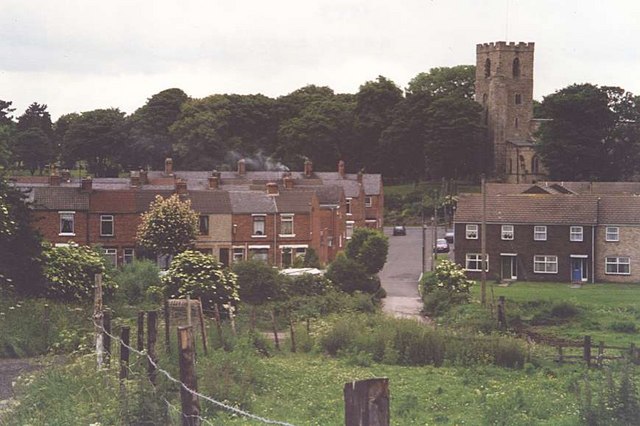
Co-Curate Page
Bishop Auckland
- Overview About Bishop Auckland Map Street View Bishop Auckland is a market town in County Durham in north located between Darlington and Durham at the confluence of the River Wear …

Co-Curate Page
Wearhead
- Overview About Wearhead Map Wearhead is a picturesque village in County Durham, located at the start of Weardale where the River Wear is begins at the confluence of Burnhope Burn …
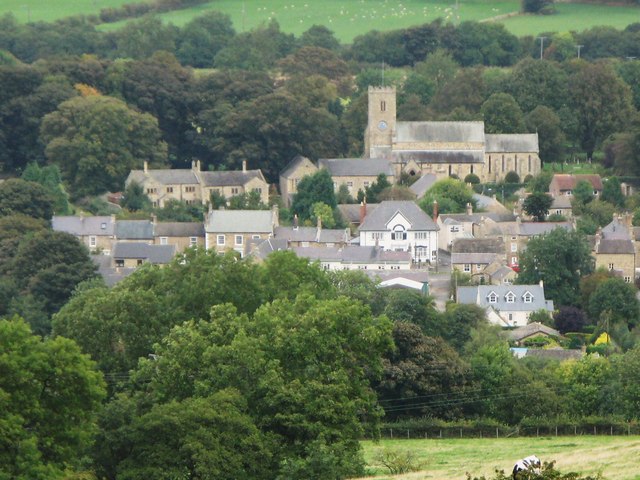
Co-Curate Page
Wolsingham
- Overview History Map Street View Wolsingham sits at the confluence of the River Wear and Waskerley Beck. It is a small settlement and one of the first market towns …
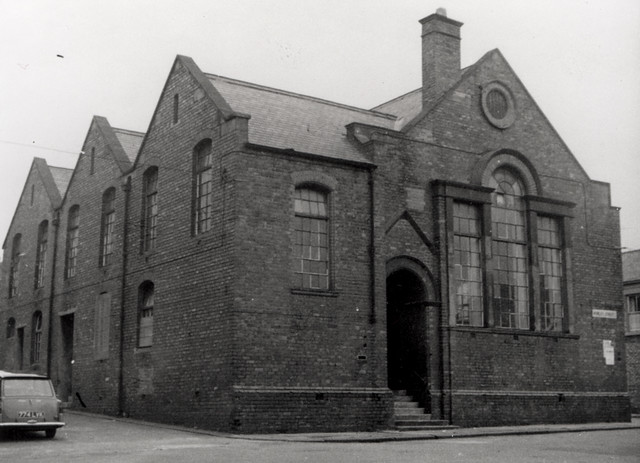
Co-Curate Page
Stanhope
- Overview About Stanhope Map Street View Stanhope (pronounced in the regional dialect "Stanup") is a small market town in County Durham, in England. It is situated on the River …
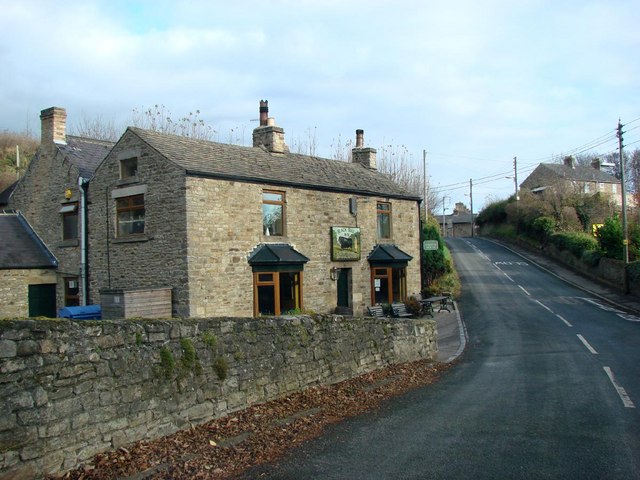
Co-Curate Page
Frosterley
- Overview About Frosterley Map Street View Frosterley is a village in County Durham located by the River Wear in Weardale, between Wolsingham and Stanhope. Frosterley has a station on the …
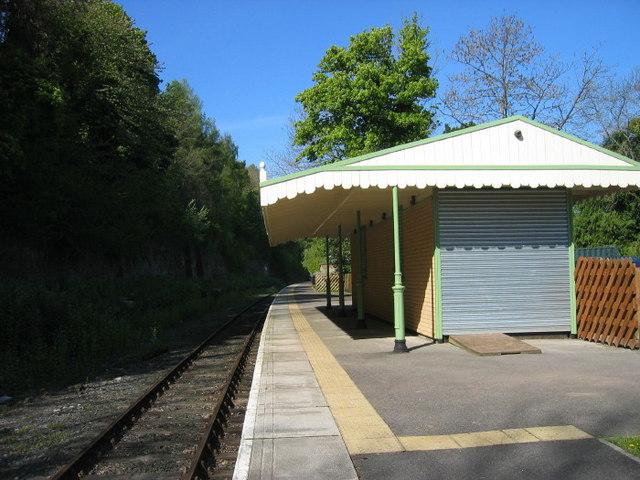
Co-Curate Page
Railway Station
- Overview Map Street View The railway station at Wolsingham was built in 1847 for the Stockton and Darlington Railway for the Wear Valley branch line. The track is now used …


from Flickr (flickr)
Stockton and Darlington, Weardale and Redcar Railways timetable 1847
Pinned by Simon Cotterill

from http://www.weardale-railway.o…
Weardale Railway Trust
- "The Weardale Railway Trust is a partner in the Weardale Railway Project. We are the supporting volunteer charity for the project and work with the local authority, Durham County Council, …
Added by
Simon Cotterill

from Geograph (geograph)
Last Train waiting to leave Wearhead for Bishop Auckland, 1953
Pinned by Simon Cotterill

Co-Curate Page
Bishop Auckland
- Overview About Bishop Auckland Map Street View Bishop Auckland is a market town in County Durham in north located between Darlington and Durham at the confluence of the River Wear …

Co-Curate Page
Wearhead
- Overview About Wearhead Map Wearhead is a picturesque village in County Durham, located at the start of Weardale where the River Wear is begins at the confluence of Burnhope Burn …

Co-Curate Page
Wolsingham
- Overview History Map Street View Wolsingham sits at the confluence of the River Wear and Waskerley Beck. It is a small settlement and one of the first market towns …

Co-Curate Page
Stanhope
- Overview About Stanhope Map Street View Stanhope (pronounced in the regional dialect "Stanup") is a small market town in County Durham, in England. It is situated on the River …

Co-Curate Page
Frosterley
- Overview About Frosterley Map Street View Frosterley is a village in County Durham located by the River Wear in Weardale, between Wolsingham and Stanhope. Frosterley has a station on the …


